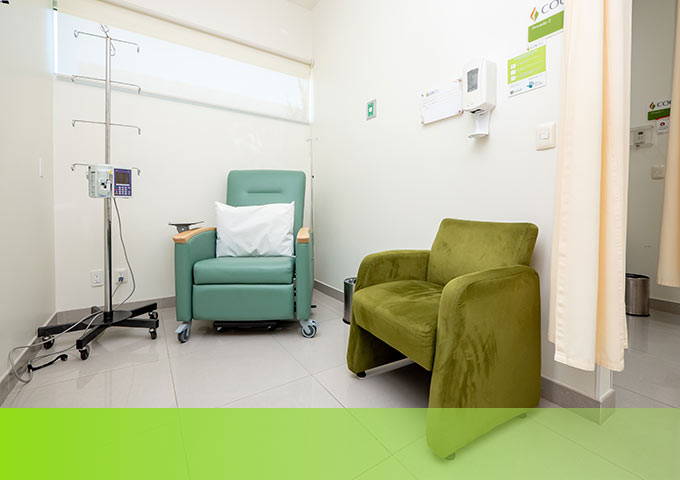Chemotherapy
The Chihuahua Cancer Center is recognized as a leader in providing successful chemotherapy treatments for various types of cancer.
Our multidisciplinary approach to care is based on a prestigious and experienced medical and nursing team, as well as various disciplines that aim to minimize side effects. Additionally, we rely on evidence-based medicine through international clinical guidelines.
Chemotherapy works by halting or slowing down the growth of cancer cells, which tend to grow and divide rapidly. Chemotherapy is used to cure cancer, as well as to minimize chances of recurrence. It is also employed to halt its progression, slow down its growth, and reduce tumors that cause pain and other issues.
Chemotherapy treatment.
Chemotherapy involves the use of medications for cancer treatment. Its effect is known as systemic because it affects the entire body, unlike radiation therapy and surgery, which only target a specific part of the body.
There are over 100 chemotherapy medications, which can be used individually or in combinations. Additionally, some medications are effective against different types of tumors.
When chemotherapy is used before surgery, it is known as neoadjuvant therapy; if it is used after surgery, it is called adjuvant.
Before undergoing chemotherapy, it’s important to communicate with your doctor to understand the treatment’s objectives, administration process, duration, and potential side effects. If any doubts remain after the initial consultation, it’s essential to take the time at home to write down any questions you want your doctor to address.

The Chihuahua Cancer Center also has nutrition and psychology departments.
Someone should accompany you when you come to your appointments, so they can assist you and take note of any information provided by your doctor.
The type of chemotherapy used depends on the specific tumor being treated, so the duration and frequency vary according to the type of cancer. Therefore, the side effects vary depending on the type of treatment employed. Prior to starting your treatment, you’ll need to sign an informed consent. This document confirms your agreement, understanding, and acknowledgment of the benefits and risks associated with your treatment.
Aside from oral and intravenous administration, chemotherapy can also be delivered intrathecally. This involves injecting the medication into the fluid-filled space surrounding the brain and spinal cord’s protective layers, allowing the drug to circulate directly at the level of the brain and spinal cord.
• Intra-arterial:
When medication is injected into a specific area of the body, such as the liver, arm, or leg, it's called regional chemotherapy.
• Intracavitary:
A catheter is placed in the abdominal cavity. This is also known as intraperitoneal chemotherapy or thoracic cavity chemotherapy.
• Intramuscular:
Chemotherapy is administered like any other injection.
• Intralesion:
Injected directly into the skin tumor under the skin or into an internal organ.
• Topical
Applied directly on the lesion in the form of a cream, jelly or ointment.
It should be noted that whether applied through a vein or catheter, chemotherapy is not painful. If you feel any pain or discomfort during chemotherapy, please let your nurse know immediately.
Before your chemotherapy session, your doctor will generally order blood tests such as blood count, blood chemistry, and liver profile to ensure that you are fit to receive your treatment.
If you are going to take any medication not prescribed by your oncologist, you should let your oncologist know to make sure that medication does not interfere with your treatment. This also applies to alternative treatments.
Your oncologist will tell you what type of imaging tests are needed to assess your evolution and response to treatment.
Safety measures during chemotherapy.
Please note that chemotherapy can impair your body’s ability to fight infections, so you should refrain from visiting anybody who may be ill and from receiving visitors.
You should wash your hands before touching your nose, mouth and eyes, and ask your family members to wash their hands when they are with you. As a general rule, most medications are processed or eliminated from your system within 48 hours.
Most are eliminated through urine, feces, tears or vomit. As they leave your system, medications can irritate your skin. Make sure that children and pets stay away from any toilets you use, as they can be hazardous to them during this time.
You should flush the toilet twice and lower the lid to avoid splashing. Both men and women should sit on the toilet to avoid splashing, wash their hands after using the toilet, and dry them with paper towels that should then be discarded in the trash can.
If the toilet is used for vomiting, any splashes should be cleaned up. If vomit is emptied from a container into the toilet, flush the toilet twice. The container that held the vomit should be washed with soap and water and dried with paper towels which should then be discarded in the trash.
Anyone caring for the patient must use disposable gloves when coming into contact with secretions and wash their hands before and after coming into contact with the patient. Clothing or sheets that have body fluids on them should be washed in a washing machine and not by hand. Do not wash together with other clothes. Place disposable diapers and adult disposable underwear in a double plastic bag, close the bag and throw it in the trash.
Patients are often concerned about whether they will be able to work. This will depend on the side effects of the medications, the patient’s tolerance to them, and the type of work to be performed, so the doctor and patient must discuss and decide if it’s advisable for the patient to work. Many patients are able to work.

Chemotherapy’s most common side effects.
Just as cancer cells are affected by chemotherapy, so are normal cells with the capacity for growth. These include bone marrow cells (red blood cells, white blood cells, platelets). This can make you susceptible to conditions like anemia, infections, and bleeding, depending on the severity.
You should contact your doctor if you have a fever, or if you experience nose, gum, or other bleeding. The cells that line the mouth and digestive tract are also affected, which can cause sores and be painful. The reproductive system can be affected in patients who still menstruate; it’s common during treatment for menstruation to stop.
Lastly, hair follicles are affected, causing hair loss (this will be temporary, as hair typically grows back once treatment is completed). Some side effects disappear days after finishing treatment, while others may last for months or even years, and some can be permanent. This depends on the type of medication used, so it’s essential to discuss it with your doctor.
The Chihuahua Cancer Center is recognized as a leader in providing successful chemotherapy treatments for various types of cancer.
Our multidisciplinary approach to care is based on a prestigious and experienced medical and nursing team, as well as various disciplines that aim to minimize side effects. Additionally, we rely on evidence-based medicine through international clinical guidelines.

